|
|
| ■“Practice in Architectural Design”, Major of Architecture, Mukogawa Women’s University |
The 1st and 2nd grade Master’s course students in the Architecture Major participate in on-going projects both inside and outside of the campus and conduct practical training on such as the design of new building, reconstruction, preservation, restoration, in the graduate class, “Practice in Architectural Design”, (5 times per week, 10 credits), with the supervision of a first class authorized architecture design office, “Architecture and Urban Design Studio, MWU”. This time, students have worked on plans in detail, CG perspective drawings, mock-ups and researched the details considering the cost and construction method also and proposed the designs of such as exterior, platform, and concourse. In the meeting, students themselves held presentation using drawings and mock-ups prepared by them. |
| |
 |
Participation in the meeting with the railway company |
| |
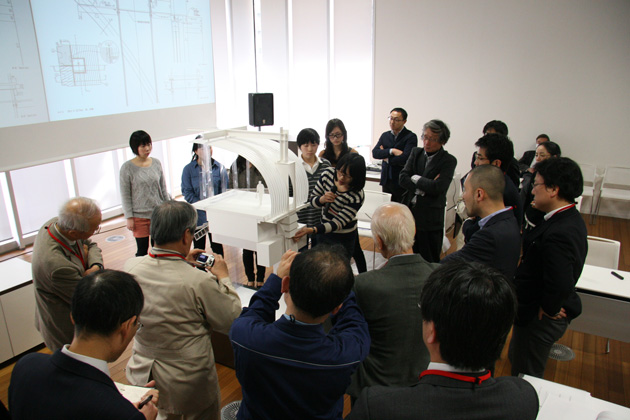 |
Explanation of construction method using 1/10 scale model |
| |
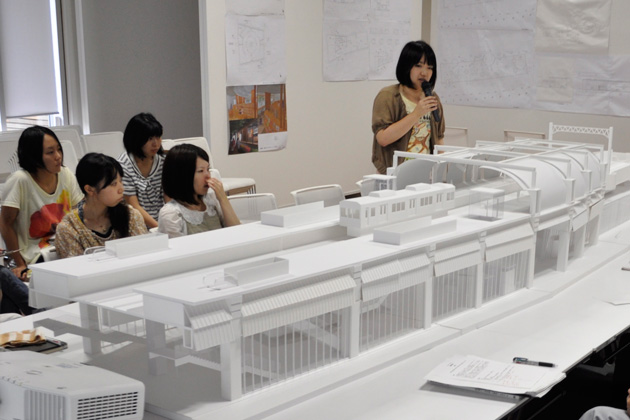 |
Explanation of appearance design using 1/30 scale model |
| |
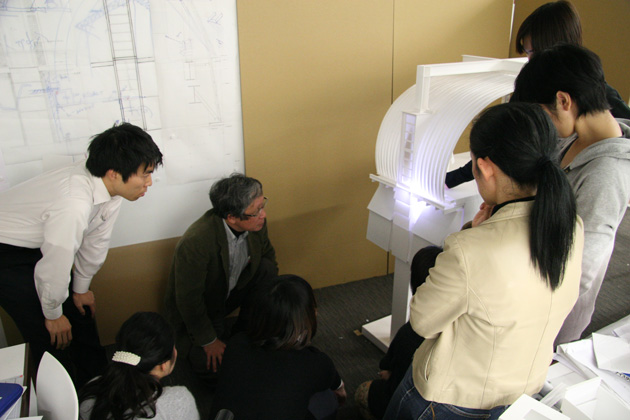 |
Analyzing lighting plan using 1/10 scale model |
| |
 |
Measurement of surface temperature of plank sheet |
| |
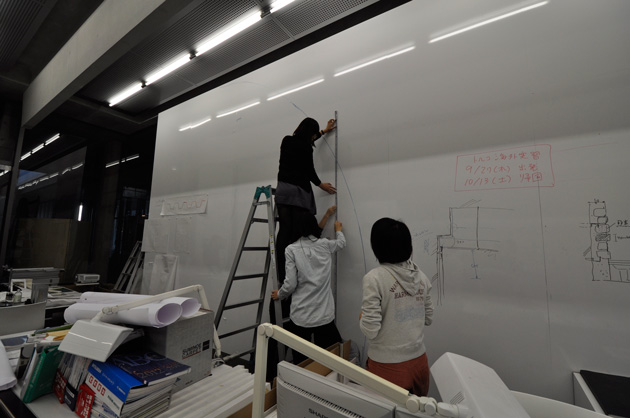 |
Confirmation on scale sensitivity using full-scale drawing |
| |
| ■Symbolic space |
Symbolic character is basically required for spaces of stations. The symbolic character means the relationship between the objects and human, such as color of traffic lights; human acts unconsciously with seeing the color of the light. That is to say, the symbolic space has the characteristics to make people act unconsciously. Owing to the symbolic space in stations, when someone see a stair after getting off the train, he unconsciously walks towards the stair, or when he see an entrance gate, he walks towards the entrance gate to find the exact exit. In stations, stairs, entrance gates, escalators, elevators, signs and so on play a role as symbolic components for passengers as well as colors of traffic lights. These symbolic components should be seen clearly without being interrupted by other components of the space. And to do that, the other components such as structures, facility equipment, advertisements and so on except the symbolic components should be inconspicuous. However, these non-symbolic components are not regulated at all in stations in our country and they scatter everywhere in the stations, making difficult to understand the space perception.
|
| |
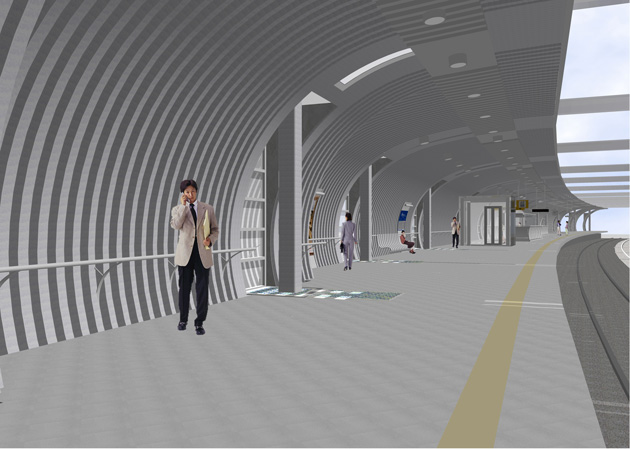 |
View of the west side from the Kobe platform |
| |
| ■Simple and homogeneous space created by Plank Sheet |
Plank Sheet, which is steel plate with 2.7mm thickness and 100mm height, is curved gently and fixed at two points; the roof top of the railway track side and the floor of the opposite side of the railway track. The plank sheet does not require any support and finishing materials. The each platform is involved with the curves of the uninterrupted sheet which consists of roof and wall. This plank sheet can achieve the symbolic space meaning as highlighting the necessary comportment in stations such as stairs and role as the dynamic component of the station harmonizing to the high-speed trains which represent advancing technologies. The plank sheet has also adequate strength for hanging signs. |
| |
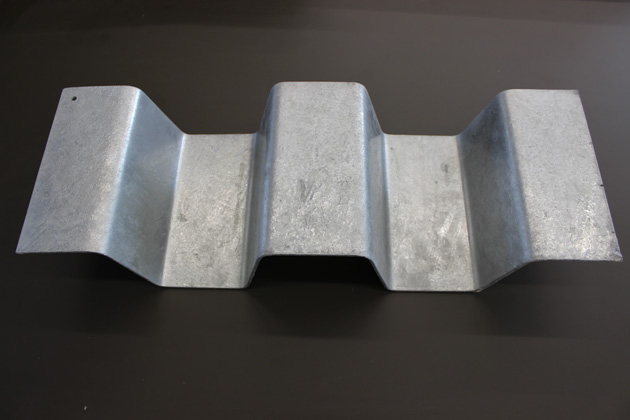 |
| Plank Sheet |
| |
| ■Rational spaces of station ear university |
A university symbolizes research, education as well as culture. A space required for such institution should be rational and classical such as roman architectures, neither decorative nor emotional for amusing theater or music hall of expressionism such as baroque architectures. The solemn atmosphere is essential to Naruo station, as a station which locates near Mukogawa Women’s University. |
| |
| ■Design fashioning the images of historical and traditional landscapes |
In ancient time, the Naruo area was known as a scenic spot for a number of Waka poets, a quality that today has been forgotten. |
西行法師「新拾遺和歌集」秋の始め鳴尾といふ所にてよめる
常よりも秋になる尾の松風は分きて身にしむ物にぞありける
隆西法師「夫木和歌抄」
浦さびて哀れなるをの泊かな松風をえて千鳥鳴くなり
大江貞重「續千載和歌集」
やゝ寒きなるをの里の秋風に波かけ衣うたぬ日もなし
慈鎮「拾玉集」
我身こそ鳴尾にたてる一つ松よくもあしくも又たぐひなし
權大納言実家「千載和歌集」
けふこそは都のかたの山のはもみえずなるをの沖に出でぬれ
源家長「續古今和歌集」
生駒山よそになるをの沖に出でゝ目にもかゝらぬ嶺のあま雲
真意法師「新後撰和歌集」
逢ふことはよそになるをの沖津波うきてみるめのよるべだになし
また広く知られた謡曲「高砂」では
高砂や この浦舟に 帆を上げて
この浦舟に帆を上げて
月もろともに 出汐の
波の淡路の島影や 遠く鳴尾の沖過ぎて
はやすみのえに 着きにけり
はやすみのえに 着きにけり
四海波静かにて 国も治まる時つ風
枝を鳴らさぬ 御代なれや
逢ひに相生の松こそ めでたかりけれ
げにや仰ぎても ことも愚かや
かかる世に住める 民とて豊かになる
君の恵みぞ ありがたき
君の恵みぞ ありがたき |
Wind through rows of pines on seashore and sailing boats coming and going through the sea can be imagined. Curves of the plank sheet covering the station platforms are inspired by the sails filling with the wind. |
| |
|
| View from south west side |
| |
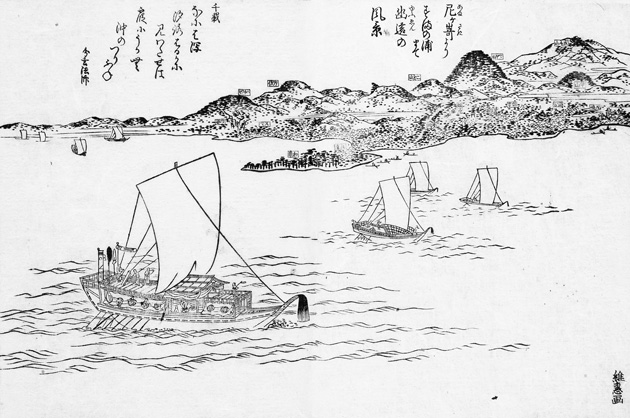 |
Scene of sightseeing from Amagasaki to Sumaura in “Settsu-meisho-zue” owned by Mukogawa Women's University Library |
|
Hanshin Electric Railway Co., Ltd.
Architectural Design Studio in Mukogawa Women’s University
Shigeyuki OKAZAKI: Professor Emeritus, Kyoto University,
Professor, Head, Department of Architecture, Mukogawa Women's University
Mamoru KAWAGUCHI: Professor Emeritus, Hosei University,
President, KAWAGUCHI & ENGINEERS,
Visiting Professor, Mukogawa Women's University
Department of Architecture, Mukogawa Women’s University, Japan
Noritoshi SUGIURA
Keisuke INOMATA
Junko MORIMOTO
Aya YAMAGUCHI |

